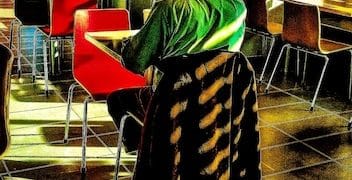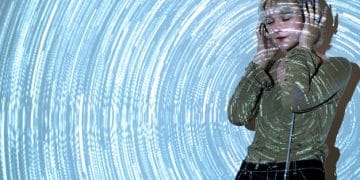Mastering Live Looping: US Underground Musician’s Essential Guide
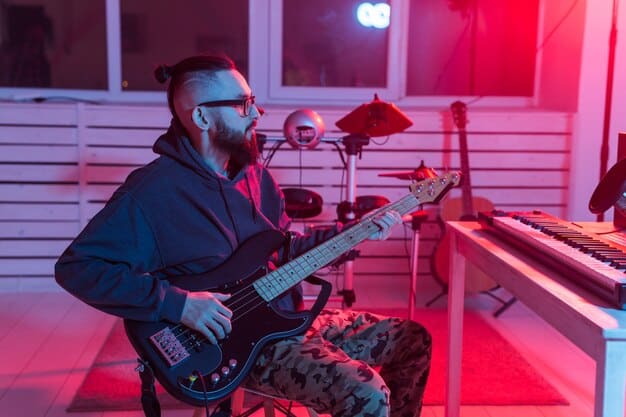
Mastering live looping empowers underground musicians in the US to create rich, layered performances using real-time audio recording, enhancing their artistry, expanding creative possibilities, and delivering unique experiences to audiences.
In the vibrant, ever-evolving landscape of underground music, artists constantly seek innovative ways to captivate audiences and express their unique sonic visions. One technique that has profoundly reshaped the live performance paradigm is Mastering the Art of Live Looping: A Practical Guide for Underground Musicians in the US. This approach allows musicians to build intricate, multi-layered soundscapes in real-time, transforming solo acts into orchestral experiences or augmenting ensembles with dynamic textural depth. It’s a skill that elevates performance, fosters improvisation, and can redefine an artist’s signature sound.
Understanding the Foundation of Live Looping
At its core, live looping involves recording and playing back a short segment of audio in real-time, creating a continuous, repeating phrase. This foundational loop then serves as a canvas upon which subsequent layers of audio can be added, built up sequentially to form complex arrangements. For underground musicians, this offers an unparalleled degree of creative freedom and performance flexibility, enabling them to construct full soundscapes from minimal instrumentation or even just their voice.
The beauty of looping lies in its immediacy and responsiveness. Unlike pre-recorded tracks, live loops are created in the moment, reflecting the energy and improvisation of the performance. This real-time creation fosters a unique connection with the audience, who witness the piece unfolding organically. It’s a testament to the performer’s skill and artistic vision.
Essential Gear for Starting Your Looping Journey
Embarking on the live looping adventure requires a few key pieces of equipment. While the market offers a vast array of devices, a solid starting setup doesn’t need to break the bank, especially for underground artists who often prioritize functionality and portability.
- Loop Pedal: This is the heart of your setup. Popular choices range from simple, single-track pedals like the BOSS RC-1 to more advanced, multi-track units such as the Ditto X4 Looper, offering greater control over individual loops.
- Microphone/Instrument: Whatever your primary sound source is—be it vocals, guitar, keyboard, or even unconventional instruments—you’ll need a way to feed it into your loop pedal. A good quality microphone or direct instrument input is crucial for clean recordings.
- Amplification/PA System: To project your intricate sonic creations, you’ll need an amplifier or a connection to a venue’s PA system. The clarity and fidelity of your amplification will significantly impact the audience’s experience.
Beyond these essentials, other accessories like high-quality cables, power supplies, and headphones for monitoring can greatly enhance your looping experience and the overall sound quality. Investing in reliable gear upfront can save headaches down the line.
The choice of equipment often depends on the musician’s specific needs and genre. A folk singer might prefer a straightforward, intuitive pedal for vocal and acoustic guitar loops, while an electronic artist might lean towards a multi-track workstation with extensive MIDI capabilities. Understanding your artistic goals will guide your equipment selection, ensuring that your tools serve your creative vision effectively.
Developing Core Looping Techniques and Strategies
Once you have your basic setup, the true art of live looping begins with mastering fundamental techniques. It’s not just about pressing record and play; it’s about timing, layering, and dynamic control. These elements, combined with a strong sense of musicality, transform simple loops into compelling performances.
Timing is paramount in looping. Loops must start and end precisely to create seamless repetitions. Practicing with a metronome or a drum machine can help develop this crucial rhythmic accuracy. Many loop pedals offer quantize functions, which automatically adjust your loop points to the nearest beat, but relying solely on this can hinder the development of internal rhythm.
Layering and Textural Building Blocks
The power of looping lies in its ability to build rich textures. Start with a harmonic foundation, like a bassline or a chord progression, and then add melodic counterpoints, rhythmic percussion, or ambient sounds. Each layer should contribute distinctly to the overall sonic tapestry without cluttering the mix. Think of it as painting with sound, adding colors one by one to create a complete picture.
- Rhythmic Foundation: Begin with a solid rhythmic element, such as a percussive beat or a foundational pluck, to establish the groove. This provides a stable base for subsequent layers.
- Harmonic Progression: Introduce chord changes or a bassline that provides the harmonic structure of the piece. This layer often dictates the mood and direction of your composition.
- Melodic Content: Weave in melodies that interact with your harmonic and rhythmic elements. This could be a lead vocal, an instrumental solo, or an improvised line.
- Atmospheric/Textural Elements: Add subtle drones, ambient pads, or sound effects to create depth, space, and a unique atmosphere. These layers often provide emotional context.
Experimentation is key. Try reversing loops, changing speeds, or adding effects to individual layers. Some pedals allow for independent volume control for each loop, which is vital for mixing your performance on the fly. Learning to balance your layers ensures clarity and prevents your sound from becoming muddy or overwhelming.
Structuring a looped performance involves more than just stacking sounds. Consider the narrative arc: how does the piece begin, build, evolve, and resolve? You might start sparsely, introduce new elements gradually, create moments of intensity, and then strip away layers for a dynamic conclusion. This dramatic flow keeps the audience engaged and highlights the improvisational nature of your art.
Integrating Looping into Diverse Musical Genres
Live looping is remarkably versatile, transcending genre boundaries and finding a home in everything from folk and blues to electronic music and experimental jazz. For underground musicians in the US, this adaptability is a significant asset, allowing for unique sonic exploration within their chosen niche or even enabling them to fuse disparate styles in innovative ways.
In folk and acoustic settings, looping can transform a solo singer-songwriter into a multi-instrumentalist orchestra. A guitarist can loop a rhythm track, then add a bassline, a lead melody, and even percussive body taps, creating a full-band feel. Vocalists can harmonize with themselves, constructing intricate choral arrangements on the spot. This expands the sonic palette without requiring additional band members.
Electronic and ambient artists find looping to be a natural extension of their craft. Synthesizer textures, sampled sounds, and digital beats can be layered to create immersive soundscapes. The real-time manipulation possible with loop pedals adds an organic, improvisational edge often missing from purely pre-programmed electronic music. This allows for dynamic evolution during a performance, responding to audience energy.
Jazz and improvisational musicians harness looping to explore harmonic and rhythmic ideas. A horn player might loop a complex chord progression, then improvise over it, or a bassist might lay down a groove for soloing. The ability to instantly replay and interact with one’s own musical ideas fosters spontaneous creativity and allows for deep dives into musical motifs. The possibilities are truly endless, limited only by the artist’s imagination.
Even in genres like hip-hop, beatboxing, and experimental sound art, looping provides a powerful tool for creation. Beatboxers can build full drum tracks and vocal samples, while experimental artists can manipulate field recordings or found sounds, turning everyday noises into a unique sonic tapestry. The key is to see the loop pedal not just as a device, but as an extension of your creative self, a direct link between musical thought and audible reality.
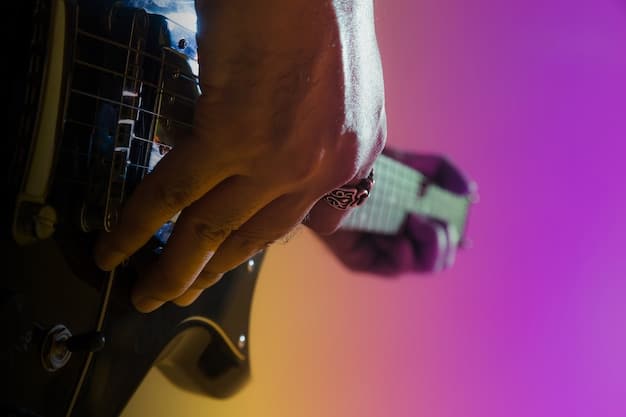
Performance Tips for Engaging Audiences with Loops
Beyond technical proficiency, captivating an audience with live looping involves performance artistry. The visual aspect of looping—the act of creating music in front of an audience—is just as important as the sound itself. Engaging your audience means demonstrating the magic of the process, not just presenting the finished product.
Show, don’t just tell. Let your audience see you build the loops. This transparency creates a sense of wonder and appreciation for the complexity of what you’re doing. Many successful looping artists make eye contact with the audience while recording a critical loop, drawing them into the creative process. Explain briefly what you’re doing if it’s a particularly complex section, but avoid over-explaining. Let the music speak.
Maximizing Audience Engagement
- Visual Transparency: Position yourself and your gear so the audience can see you engaging with the pedals. The act of creating the loop is often as fascinating as the sound itself.
- Vary Dynamics: Don’t just stack layers. Mute and unmute loops, fade elements in and out, and introduce silence to create tension and release. Dynamic variation keeps the performance from becoming monotonous.
- Direct Interaction: Incorporate audience participation by sampling their sounds, clapping, or even vocalizations. This makes them active participants in the creation.
- Storytelling: Use your loops to tell a story or evoke a specific emotion. The layers can represent different characters, moods, or narrative shifts within your sonic journey.
Audience engagement also comes from dynamic performance. Don’t let your loops play endlessly without variation. Learn to manipulate them—mute and unmute layers, fade elements in and out, and introduce changes to the overall arrangement. This keeps the performance fresh and prevents it from becoming repetitive. Consider the narrative arc of each song: how does it build, evolve, and resolve?
Embrace improvisation and the unexpected. Live looping is inherently spontaneous; sometimes happy accidents lead to the most interesting musical moments. If you make a mistake, acknowledge it, learn from it, and incorporate it into your performance if it’s salvageable. Authenticity resonates with underground music audiences, who appreciate raw, unfiltered artistry.
Finally, practice performing with your loops as much as you practice creating them. Rehearse transitions between songs, interaction with your pedals, and stage presence. The more comfortable you are with your setup, the more freely you can express yourself and connect with your audience. Remember, the goal is not just to play music, but to create an unforgettable experience.
Troubleshooting Common Looping Challenges
Even the most experienced live loopers encounter challenges. From technical glitches to creative blocks, understanding common pitfalls and having strategies to overcome them is crucial for maintaining a seamless and enjoyable performance, particularly in the often-unpredictable environment of underground music venues.
One of the most frequent issues is timing inaccuracy. A loop that isn’t perfectly in time can quickly derail a performance. Solutions include extensive practice with a metronome, using the quantize feature on your pedal (if available, but judiciously), and ensuring your initial loop is as rhythmically precise as possible. It’s often better to re-record a wonky first loop than to build upon a flawed foundation.
Addressing Technical Glitches and Creative Hurdles
- Latency Issues: Ensure all cables are high quality and as short as possible. Lowering your audio interface buffer size (if using software looping) can also reduce lag.
- Feedback Loops: Position microphones and amplifiers carefully to avoid feedback. Use a noise gate or consider in-ear monitors if feedback is a persistent problem in loud environments.
- Sound Quality Degradation: Over-layering can lead to a muddy sound. Prioritize clarity by carefully selecting and mixing your layers. Use EQ to carve out space for each component.
- Creative Blocks: Experiment with different instruments, scales, or genres. Watch other loopers for inspiration. Sometimes, taking a break or collaborating can rekindle creativity.
Another common problem is muddiness in the sound, often caused by too many layers competing for the same sonic space. Learning basic mixing principles, such as EQing different instruments so they occupy distinct frequency ranges, can significantly improve clarity. Many loop pedals allow you to control individual loop volumes, enabling you to mix on the fly and ensure each element is heard clearly.
Technical malfunctions, like power issues or loose cables, can stop a performance cold. Always have backup cables and power supplies. Test your entire setup thoroughly before a gig, and familiarize yourself with your pedal’s manual for quick troubleshooting. Sometimes, a simple reboot of the pedal can solve minor software glitches.
Finally, managing creative flow during a performance is a challenge. Sometimes, ideas don’t come as smoothly as anticipated. Having a repertoire of ready-to-go loops or basic chord progressions can provide a safety net. Embrace the spontaneous nature of looping; an unexpected turn can lead to something new and exciting. The ability to adapt and think on your feet is a hallmark of a truly masterful live looper.
Advanced Looping Techniques for Unique Soundscapes
Once the foundational techniques and troubleshooting strategies are firmly in hand, underground musicians can delve into more advanced looping methods to craft truly unique and immersive soundscapes. These techniques often involve pushing the boundaries of traditional looping, incorporating external effects, and exploring unconventional sound sources to elevate a performance beyond expectation.
One of the most powerful advanced techniques is asynchronous looping, where loops of different lengths are layered. This creates polyrhythmic and evolving textures that rarely repeat in exactly the same way, leading to a much more dynamic and unpredictable sonic environment. For example, a 4-beat drum loop layered with a 3-beat bassline will create a constantly shifting rhythmic interplay, demanding a keen sense of timing and musicality from the performer.
Expanding Your Looping Horizon
Beyond simple layering, integrating external effects pedals into your looping chain can dramatically alter your sound. Running individual instruments through delay, reverb, modulation, or distortion pedals before they hit the looper, or even applying effects to the entire looped output, opens up a universe of sonic possibilities. Experiment with placing effects both pre-looper (affecting only the recorded sound) and post-looper (affecting the entire stack).
MIDI synchronization is another critical advanced technique, especially for musicians incorporating synthesizers, drum machines, or software instruments. Syncing your loop pedal to an external MIDI clock ensures that all your electronic devices remain perfectly in time, even when changing tempos or time signatures. This level of precision is invaluable for complex electronic and hybrid performances.
The use of sampling and granular synthesis within a looping context presents profound creative avenues. Instead of just looping live instruments, musicians can sample vocal phrases, environmental sounds, or pre-recorded clips, then manipulate these samples in real-time. Granular processing can chop these samples into tiny “grains” and rearrange them, creating shimmering textures or abstract soundscapes that are wholly unique.
- Reverse Looping: Record a phrase and immediately play it in reverse. This creates eerie, otherworldly textures perfect for ambient or experimental passages.
- Layering with Silence: Instead of continuous sound, record loops with deliberate gaps or silent sections. This creates rhythmic interest and allows previously obscured layers to temporarily shine through.
- Controlled Feedback Looping: Deliberately introduce controlled feedback into a loop through careful mic placement or specific effects pedals. This can generate drones, self-modulating textures, or gritty, distorted sounds.
- Live Sampling & Manipulation: Beyond just looping, sample audience sounds, found objects, or spoken words, and then immediately integrate and manipulate them within your live loops, creating an interactive and spontaneous element.
Finally, exploring alternative controllers, such as MIDI foot controllers, expression pedals, or even motion sensors, can provide an ergonomic and expressive way to interact with your loop setup without taking your hands off your instrument or mic. This enables a more fluid and less visually disruptive performance, allowing the musician to focus entirely on the music.
Building Your Brand as a Looping Artist in the US Underground Scene
For US underground musicians, mastering live looping isn’t just about technical skill; it’s also a powerful tool for carving out a unique identity and building a recognizable brand within a fiercely competitive landscape. Differentiating yourself is paramount, and live looping offers a distinct performance element that can attract attention and cultivate a dedicated following.
Start by honing your unique looping style. Is it the intricate vocal harmonies? The percussive guitar work? The ambient soundscapes? Develop a signature sound that audiences can immediately associate with you. This distinct sonic fingerprint is what will make you memorable in a crowded market. Don’t be afraid to experiment and find what truly resonates with your artistic vision.
Strategies for Self-Promotion and Community Engagement
Visibility is crucial. Record high-quality videos of your live looping performances and share them across social media platforms like Instagram, TikTok, and YouTube. Short, engaging clips showcasing the “how-to” of your looping process can be particularly effective, demystifying the art form and drawing viewers in. Engage with comments and build a community around your unique approach.
- Curated Social Media Content: Don’t just post final songs. Share behind-the-scenes glimpses of your looping setup, quick tutorials for specific techniques, and snippets of your creative process to engage a wider audience.
- Collaborate with Other Artists: Seek out other underground musicians, DJs, or visual artists for collaborative projects. Looping can be a fantastic way to merge different artistic disciplines and reach new audiences.
- Leverage Live Streams: Utilize platforms like Twitch or YouTube Live for intimate looping sessions, Q&As, or even interactive songwriting where your audience can influence the loops you create.
- Network at Venues and Festivals: Actively participate in local music scenes, attend open mics, and network with venue owners, promoters, and fellow musicians. Direct connections are still invaluable in the underground scene.
Playing live is non-negotiable. Seek out opportunities to perform at local venues, open mic nights, art galleries, and small festivals—places where underground music thrives. Live performances are where your looping artistry truly shines and where you can convert casual listeners into devoted fans. The word-of-mouth generated by a captivating live looping set is incredibly powerful.
Networking within the underground music community is vital. Attend other artists’ shows, participate in local jams, and connect with fellow musicians, promoters, and venue owners. Building relationships can lead to collaboration opportunities, shared gigs, and valuable feedback that can help you refine your craft and expand your reach. Remember, the underground scene is often built on mutual support and authentic connection.
| Key Aspect | Brief Description |
|---|---|
| 🎤 Core Concept | Real-time audio recording & playback to build layered musical performances. |
| ⚙️ Essential Gear | Loop pedal, microphone/instrument, and an amplification system. |
| 🎶 Key Technique | Precise timing, strategic layering, and dynamic control for complex soundscapes. |
| 🌟 Audience Impact | Engage by showcasing the creative process and delivering unique, evolving performances. |
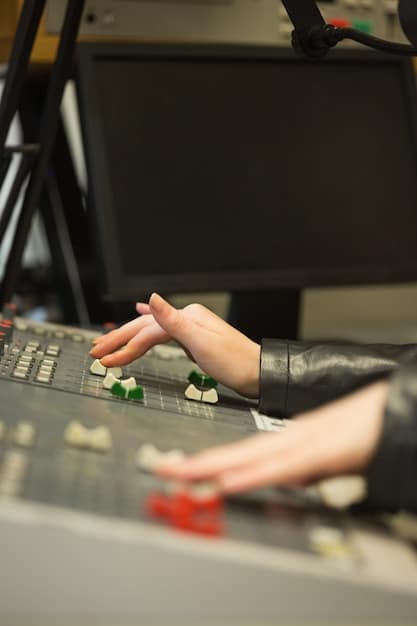
Frequently Asked Questions About Live Looping
▼
For beginners, the BOSS RC-1 and TC Electronic Ditto Looper are excellent choices. They are intuitive, robust, and focus on core looping functionality without overwhelming features, making them perfect for learning the basics of recording and layering. Both offer great sound quality and are widely available.
▼
To avoid monotony, focus on dynamic variation. Mute and unmute layers strategically, introduce new elements gradually, and remove old ones. Varying loop lengths (asynchronous looping), adding FX, and incorporating improvised soloing over the loops keeps the performance fresh and engaging. Think of it as a dynamic conversation.
▼
Absolutely, live looping isn’t just for solo artists. Bands can use it to create denser arrangements, replicate complex studio parts, or allow members to switch instruments. A bassist might loop a groove for a guitar solo, or a vocalist might add harmonies to a chorus. It enhances rather than replaces traditional instrumentation.
▼
Hardware loopers are dedicated physical pedals, offering immediate tactile control and often greater reliability in live settings. Software loopers run on computers or tablets, providing vast flexibility, track counts, and integration with other plugins. While software is more versatile, hardware often offers simpler setup and less latency for performers.
▼
Timing is critical. Practicing with a metronome is essential to develop rhythmic precision. Many loop pedals have beat-quantization features that auto-correct minor timing errors, but relying solely on them can hinder natural rhythm development. Start your first loop as perfectly as possible, as subsequent layers will build on its foundation.
Conclusion
Mastering live looping offers underground musicians in the US an unparalleled creative toolkit, empowering them to transform their performances, transcend conventional limitations, and connect with audiences in uniquely authentic ways. From understanding the core mechanics of a loop pedal to developing advanced layering techniques and strategic troubleshooting, the journey of becoming a proficient live looper is both challenging and incredibly rewarding. By embracing this art form, artists can cultivate a distinct sound, engage their listeners on a deeper level, and ultimately establish a compelling presence within the vibrant and diverse landscape of underground music. The stage is set, the loop is ready, and the possibilities for innovation are endless.

